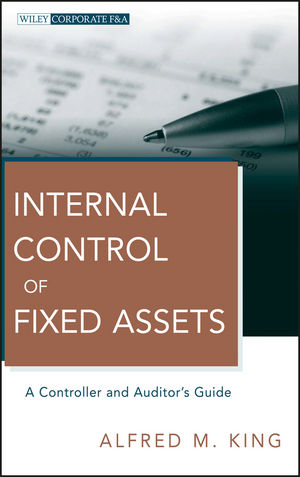Internal Control of Fixed Assets: A Controller and Auditor's GuideISBN: 978-0-470-53940-8
Hardcover
210 pages
March 2011
 This is a Print-on-Demand title. It will be printed specifically to fill your order. Please allow an additional 10-15 days delivery time. The book is not returnable.
|
||||||
Chapter 1: Internal Control, Sarbanes-Oxley, and the Public Company Accounting Oversight Board.
Internal Controls over Property, Plant, and Equipment—Mandatory but Weak.
Internal Controls over Working Capital.
Securities and Exchange Commission and Public Company Accounting Oversight Board Scrutiny of Financial Statements.
Why Do Auditors Not Spend More Time on Property, Plant, and Equipment?
Who Is Responsible for Internal Control over Property, Plant, and Equipment?
‘‘What Is So Hard about the Job?’’.
Note.
Chapter 2: Capitalization versus Expense.
Capitalization Theory.
Why Capitalization Levels Matter.
Consequences of Increasing Minimum Capitalization Level.
What Is the Optimum Capitalization Limit?
Summary.
Note.
Chapter 3: Asset Life Cycle—Controls and Software.
Software Is the Key.
Input, Output, and Reporting Capability.
How to Evaluate Software Vendors.
Assign Responsibility for Implementation and Beyond.
Charging Departments Will Ensure Individual Responsibility.
Return on Investment Analysis.
Summary.
Note.
Chapter 4: Depreciation and Amortization for Books and Taxes.
Internal Control for Depreciable Tangible Assets.
Determining Useful Lives Whenever New Assets Are Acquired.
Choosing Accounting Lives.
How Valuation Specialists Determine Economic Lives.
Determining Lives for Intangible Assets.
Changing Lives and Depreciation for Existing Assets.
Leasing as a Way to Utilize Depreciation.
Summary.
Note.
Chapter 5: Impairment Testing.
Testing Intangible Assets That Are Not Amortized.
Testing for Impairment of Property, Plant, and Equipment, and Amortizable Intangibles.
Reviewing Lives for Assets Already in Service.
Testing for Goodwill.
Reporting Units.
Determining the Fair Value of a Reporting Unit.
Phase II Test of Accounting Standards Codification 350.
Understanding Impairment Charges.
Summary.
Note.
Chapter 6: Physical Control of Property, Plant, and Equipment.
Tagging of Property, Plant, and Equipment.
Alternative Tagging Methods.
Barcode Tagging.
Radio Frequency Identification Tags.
Asset Tagging for Expensed Assets.
Recommendation.
Summary.
Notes.
Chapter 7: Taking a Physical Inventory.
Planning and Using the Physical Inventory.
Who Should Be Responsible?
Use Own Staff, or Outsource?
What Minimum Dollar Cutoff Should We Use?
Initial Effort–Partial Facility versus Total.
The $64,000 Question—Assets to Listing or Listing to Assets?
Reconciliation of the Inventory to the Records.
Fully Depreciated Assets.
Reconciliation Process.
Revised Asset Lives.
Summary.
Note.
Chapter 8: Reconciliation of Physical Inventory to Accounting Records.
Two Approaches to Reconciliation.
Ghost Assets.
Zombie Assets.
Netting Out Ghost and Zombie Assets—Is It Permissible?
Netting Out Gains and Losses.
Performing the Inventory and Reconciliation Piecemeal.
Summary.
Chapter 9: Fixed Assets in a Business Combination.
Carryover of Target’s Book Value.
Applying Indexes to the Target Company’s Asset Register.
Inaccuracies in the Target’s Asset Property Register.
Detailed Valuation of Property, Plant, and Equipment.
Summary.
Note.
Chapter 10: Insurance for Fixed Assets.
Using the Master Property Record for Insurance.
Insurable Values Are NOT Fair Value or Fair Market Value.
How Appraisers Determine Insurable Values.
Indexing.
Proof of Loss.
Summary.
Chapter 11: Property Taxes—Personal Property and Real Estate.
Reporting Fair Market Values upon Acquisition.
Equity among Taxpayers.
Appealing Personal Property Tax Assessments.
Indexed Costs May Not Reflect Fair Market Value of Property, Plant, and Equipment.
Real Estate Taxes and Appeals.
‘‘Contingency’’ Consultants.
Summary.
Note.
Chapter 12: Developing the Fair Value of Fixed Assets.
What Is the Fair Value of Property, Plant, and Equipment?
Value in-Use of Property, Plant, and Equipment.
What Would Happen if Fair Value Reporting for Property, Plant, and Equipment Was Required?
Connection between Fair Value and Book Value.
What Would Investors Learn from Fair Value Disclosures of Property, Plant, and Equipment?
Summary.
Chapter 13: Control of Fixed Assets under International Financial Reporting Standards.
Component Depreciation.
Asset Revaluation.
Investment Property.
What Is the ‘‘Cost’’ of Property, Plant, and Equipment?
Summary.
Note.
Chapter 14: Component Depreciation for Buildings.
International Financial Reporting Standards Has a Different Approach.
Component Depreciation for Taxes.
Complying with Internal Revenue Service Requirements.
Internal Revenue Service Review of a Cost Segregation Study.
Cost Segregation Study for New Construction.
Will Cost Segregation Lower My Property Tax Expenses?
Componentization for Financial Reporting.
Summary.
Note.
Appendix: Excerpt of Internal Revenue Service Cost Segregation Audit Guide.
Introduction.
What Are the Most Common Methodologies Utilized for Cost Segregation Studies?
What Are the Attributes of Various Cost Segregation Methodologies?
Detailed Engineering Approach from Actual Cost Records.
About the Author.
Index.



